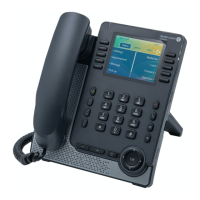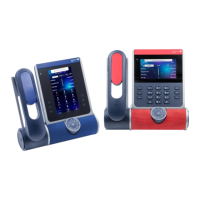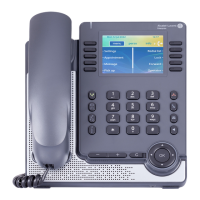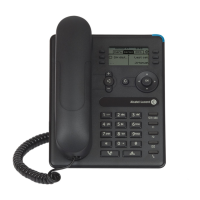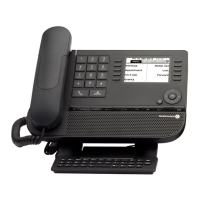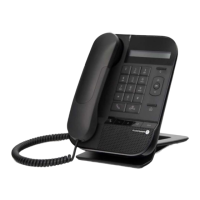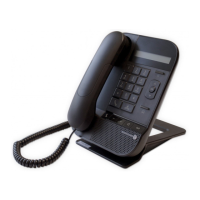Do you have a question about the Alcatel-Lucent ALE-2 and is the answer not in the manual?
Lists the primary features and capabilities of the ALE-2/ALE-3 desk phones.
Overview of the ALE-2 model, its display, keys, and capabilities.
Overview of the ALE-3 model, its color display, keys, and capabilities.
Describes the layout and information displayed on the phone's main screen.
Explains the interface used for managing calls, including soft keys and display elements.
Details the functionality of navigation keys for menu interaction and data entry.
Describes the fixed function keys and their primary uses like answering or ending calls.
Lists and explains icons associated with programmable keys for various functions.
Explains icons indicating call status and phone system states.
Explains how to use the dialpad for entering numbers and text.
Details the various ports available on the desk phone for connectivity.
How to view phone status, events, and general information.
Configuration and management of multiple SIP accounts on the desk phone.
Various methods for initiating a phone call from the desk phone.
Procedures for answering incoming calls using different audio modes.
How to switch between handset, headset, and handsfree audio during a call.
Using the redial function to call the last dialed numbers.
Managing contacts and groups in the phone's local directory.
Accessing and managing the history of incoming, outgoing, and missed calls.
Setting up and using speed dial keys for quick dialing.
Transmitting DTMF tones for automated systems or voice servers.
How to mute or unmute the microphone during a conversation.
Configuring the phone to automatically answer incoming calls.
Setting up and managing intercom calls.
Procedure for changing the phone's PIN code.
Enabling and disabling the phone lock feature for security.
Actions available while actively on a call.
How to initiate a new call while another call is active.
Procedures for handling a second incoming call.
Managing calls when a second call is active and the first is on hold.
How to toggle between active and held calls.
Procedures for transferring calls to other contacts or on hold.
How to put an active call on hold and resume it later.
Setting up and managing three-party conference calls.
Setting up and managing six-party conference calls.
Configuring the phone to hide the caller ID when making calls.
Setting up the phone to reject calls from blocked numbers.
Enabling and disabling the Do Not Disturb feature.
Configuring call forwarding to specified numbers.
Disabling previously set call forwarding rules.
Accessing and listening to voicemail messages.
Setting up a dedicated number for immediate dialing.
Setting up VPN for secure remote access and connectivity.
Using the desk phone with your own account across different locations.
Customizing ringtones, volume, and beep modes for audio alerts.
Changing the display language of the desk phone.
Configuring screen brightness and backlight settings.
Setting up screen saver functionality and its activation delay.
Customizing the idle screen wallpaper on ALE-3 models.
Adjusting the layout and display mode of the phone's homepage.
Setting the number to access voicemail services.
Creating, deleting, and defining types of programmable keys.
Answering calls for colleagues or specific groups.
Enabling and using headset functionality with the phone.
Setting the preferred format for displaying time and date.
Locating technical and date codes on the device for support purposes.
Accessing information on software version, IP, and MAC addresses.
Details on accessing advanced settings and web management.
Information about compatible ALE RJ9 and USB headsets.
Instructions and information on using a wall mounting kit.
Specifications for the compatible Ethernet cable.
Important safety guidelines for using the desk phone.
Lists the primary features and capabilities of the ALE-2/ALE-3 desk phones.
Overview of the ALE-2 model, its display, keys, and capabilities.
Overview of the ALE-3 model, its color display, keys, and capabilities.
Describes the layout and information displayed on the phone's main screen.
Explains the interface used for managing calls, including soft keys and display elements.
Details the functionality of navigation keys for menu interaction and data entry.
Describes the fixed function keys and their primary uses like answering or ending calls.
Lists and explains icons associated with programmable keys for various functions.
Explains icons indicating call status and phone system states.
Explains how to use the dialpad for entering numbers and text.
Details the various ports available on the desk phone for connectivity.
How to view phone status, events, and general information.
Configuration and management of multiple SIP accounts on the desk phone.
Various methods for initiating a phone call from the desk phone.
Procedures for answering incoming calls using different audio modes.
How to switch between handset, headset, and handsfree audio during a call.
Using the redial function to call the last dialed numbers.
Managing contacts and groups in the phone's local directory.
Accessing and managing the history of incoming, outgoing, and missed calls.
Setting up and using speed dial keys for quick dialing.
Transmitting DTMF tones for automated systems or voice servers.
How to mute or unmute the microphone during a conversation.
Configuring the phone to automatically answer incoming calls.
Setting up and managing intercom calls.
Procedure for changing the phone's PIN code.
Enabling and disabling the phone lock feature for security.
Actions available while actively on a call.
How to initiate a new call while another call is active.
Procedures for handling a second incoming call.
Managing calls when a second call is active and the first is on hold.
How to toggle between active and held calls.
Procedures for transferring calls to other contacts or on hold.
How to put an active call on hold and resume it later.
Setting up and managing three-party conference calls.
Setting up and managing six-party conference calls.
Configuring the phone to hide the caller ID when making calls.
Setting up the phone to reject calls from blocked numbers.
Enabling and disabling the Do Not Disturb feature.
Configuring call forwarding to specified numbers.
Disabling previously set call forwarding rules.
Accessing and listening to voicemail messages.
Setting up a dedicated number for immediate dialing.
Setting up VPN for secure remote access and connectivity.
Using the desk phone with your own account across different locations.
Customizing ringtones, volume, and beep modes for audio alerts.
Changing the display language of the desk phone.
Configuring screen brightness and backlight settings.
Setting up screen saver functionality and its activation delay.
Customizing the idle screen wallpaper on ALE-3 models.
Adjusting the layout and display mode of the phone's homepage.
Setting the number to access voicemail services.
Creating, deleting, and defining types of programmable keys.
Answering calls for colleagues or specific groups.
Enabling and using headset functionality with the phone.
Setting the preferred format for displaying time and date.
Locating technical and date codes on the device for support purposes.
Accessing information on software version, IP, and MAC addresses.
Details on accessing advanced settings and web management.
Information about compatible ALE RJ9 and USB headsets.
Instructions and information on using a wall mounting kit.
Specifications for the compatible Ethernet cable.
Important safety guidelines for using the desk phone.
| SIP Accounts | 2 |
|---|---|
| Ethernet Ports | 2 (10/100 Mbps) |
| PoE | Yes |
| Headset Port | RJ9 |
| Supported Protocols | SIP |

